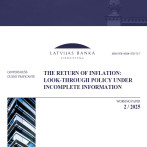Seasonal factors push consumer prices down
In July, consumer prices declined primarily on account of seasonal factors (e.g. for vegetables, wearing apparel and footwear) and also under the impact of favourable dynamics of global oil product prices in the previous months (for natural gas and heating energy). As a result, a 0.3% price drop was observed over a month (July versus June). In July of the previous year, the recorded decrease in the average consumer price level was somewhat stronger, while the impact of other factors with an upward effect on prices has also accumulated in the course of the year. That is why year-on-year (July 2013 versus July 2012), a 0.3% price increase has been observed.
The impact of both seasonal factors and global prices on consumer prices was in general favourable in July. Similar to stronger price declines, steeper price rises in July also were of pronounced seasonal nature (within a month, hotel services posted an 8.4% pickup, while tourism services became 2.4% more expensive); nevertheless, their pressure on inflation is considerably weaker due to a more modest expenditure share in the consumption basket. Consumer price changes in July were not out of the ordinary. It may have partly been on account of the initiative "Fair Euro Introducer", which, similar to the invitation to Latvia to join the euro area, was launched in July.
The price dynamics of oil products in previous months was favourable for the regulated price developments: after a longer break, the prices of gas and heating energy recorded a notable annual downturn (over 7% for heating energy). Even though a month-on-month increase in average monthly oil (Brent) price in the global market was observed already in July, it did not happen by leaps or at a particularly rapid pace. As a result, fuel prices in the domestic market grew at a balanced pace, going up by 1.4% over the month and falling behind their historically highest monthly average by 7.9%.
Along with the demand and production opportunities as major factors, the role of energy resources price dynamics is not of minor importance in the harvesting season. In July, the global food and agricultural product prices were on a downward trend for the third consecutive month, affecting absolutely all major commodity groups, cereals in particular. In July, consumer prices of cereal products decreased in Latvia's market as well.
Annual inflation is low and is expected to linger at low levels in the near term due to moderate price dynamics in the world and a balanced domestic economic growth. In addition, the approaching changeover to the euro and the related public awareness and consumer protection initiatives are among the factors underpinning quite unlikely price revisions in many areas in the near future. The delays in resolving the energy market problems also make businesses hesitate or reconsider changing their tariff plans or leaving them unchanged. On account of both supply-side factors (such as excise tax on tobacco) and demand side ones (in line with faster and more stable economic growth), the average annual inflation level is expected to go up somewhat in 2014.
Textual error
«… …»






